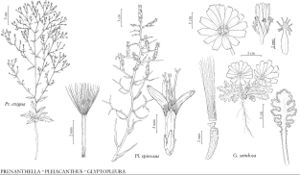Glyptopleura
in S. Watson, Botany (Fortieth Parallel), 207, plate 20, figs. 11–18. 1871.
| Taxon | Illustrator ⠉ | |
|---|---|---|
 | Prenanthella exigua Pleiacanthus spinosus Glyptopleura setulosa | Yevonn Wilson-Ramsey Sheila Flinchpaugh John Myers |
Annuals, 1–6 cm (low-growing, densely cespitose, herbage glabrous); taprooted. Stems 1–25+, ± prostrate, simple or branched, glabrous. Leaves basal and cauline, crowded; petiolate or sessile; basal blades ± oblanceolate, margins dentate or pinnately lobed and crustose-denticulate, cauline progressively reduced to oblanceolate, crustose-denticulate bracts. Heads (1–3) borne singly or 2–3 in bract-axils. Peduncles not distally inflated, often bracteate. Calyculi of 5–8, linear to oblanceolate bractlets in ± 1 series, apices expanded, crustose-denticulate. Involucres cylindric to urceolate, 3–8+ mm diam. Phyllaries 5–8+ in 1–2 series, commonly purplish-tinged, linear, equal, margins scarious, apices acute. Receptacles ± flat, smooth, glabrous, epaleate. Florets 7–18; corollas white to pale-yellow, becoming pink-purple (especially when dry). Cypselae straw-colored or light-brown, subcylindric or slightly flattened, often curved, abruptly beaked, obtusely 4–5-angled, ribs transversely roughened, alternating with 5 rows of pits, glabrous or minutely puberulent; pappi falling (outer, individually) or ± persistent (inner, connate at bases in easily fractured rings), of 50–80+, white, barbellulate to smooth bristles in 3–4+ series. x = 9.
Distribution
w United States
Discussion
Species 2 (2 in the flora).
A molecular phylogenetic investigation by J. Lee et. al (2003) provided evidence that Glyptopleura is part of a primarily western North American radiation in Cichorieae. That study did not resolve the relationship of Glyptopleura to other genera within the radiation.
Selected References
None.
Lower Taxa
Key
| 1 | Ligules 4–10 mm, equaling involucres or exserted 1–5 mm | Glyptopleura marginata |
| 1 | Ligules 15–25 mm, exserted 10–20 mm | Glyptopleura setulosa |
"fine" is not a number.